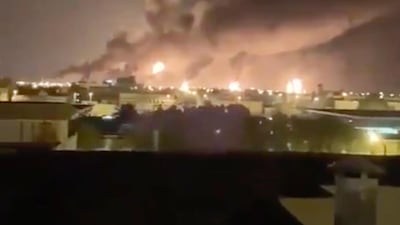Oil prices jumped more than 19 per cent as it resumed trading on Monday – the highest in more than two decades – after attacks on Saudi Arabian facilities took half the country’s output offline.
Brent, the European benchmark for light, sweet crude rose as high as $71.95 per barrel as markets began to price in a geopolitical risk premium into prices after the facility in Abqaiq, the largest oil stabilisation plant in the kingdom, came under attack.
West Texas Intermediate, the benchmark tracking largely North American crude, jumped 15 per cent to reach $63.34 per barrel at the start of trading. Prices subsequently fell back and by 6.15pm UAE time, Brent was trading up 9 per cent at $66.40 per barrel, while WTI had also settled up 9 per cent at $60.30.
Saudi Aramco has shut 5.7 million bpd of production – or 5 per cent of global supply – after plants in Abqaiq and the Khurais oilfields were attacked by more than 10 drones and, possibly, cruise missiles. The air strikes were claimed by the Iran-backed Houthi rebels in Yemen.
Saudi Arabia is the world's largest exporter of oil, accounting for 13 per cent of global production capacity, according to the BP Statistical Review of World Energy 2019. The kingdom, which has maintained production below 10 million bpd as part of a global pact to restrain output, pumped 9.80 million bpd last month.
The attacks, which hit at the centre of the Saudi energy hub in the Eastern Province, which has the world's largest oilfield, are the most debilitating so far on the kingdom's energy sector. Earlier attacks, which the Houthis also claimed, caused less damage to a pipeline with a capacity to transport 5 million bpd and a gas facility. There have also been several attacks on Saudi tankers transiting the Strait of Hormuz.
Saudi Arabia intends to meet its export requirements by drawing on its crude stocks, the new Energy Minster, Prince Abdulaziz bin Salman, said on Sunday. Around 50 per cent of the country's gas production has also been shut down.
Saudi Aramco said in a statement in the early hours of Sunday morning that further updates on the damage and restoration of production would be available “in 48 hours”.
As a result of loss of production, Saudi Arabia's real gross domestic product growth could be lowered by 1.2 to 1.4 percentage points in a scenario where it will take a month to fully restore its output, according to Monica Malik, chief economist at ADCB. The bank based its assumptions on a loss of 5.7 million bpd for the first two weeks, and a 2.5 million bpd loss for the subsequent two weeks.
"This lower growth outlook also takes into account the potential impact on Saudi petrochemical companies, including Sabic, due to curtailment of feedstock supplies,” she said.
Ratings agency Moody's on Monday said the attacks on the Saudi facilities were "credit negative" calling the production disruption "significant" but unlikely to leave "a long-lasting impact on Saudi Aramco’s financial profile".
Meanwhile, US President Donald Trump said on Twitter on Monday he would open up his country's strategic reserves to supply the markets, if needed.
The current US administration has been pushing for lower prices, especially in the run-up to the next presidential election in 2020.


